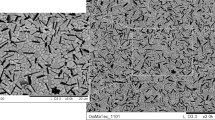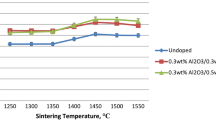Abstract
Due to its superior mechanical properties, yttrium-stabilized tetragonal zirconia polycrystal is considered as one of the most promising materials to manufacture prosthetic frameworks, monolithic crowns, and abutments for implants in dentistry. When stabilized in the tetragonal phase, the structure of zirconia can respond to external stress by increasing its toughness and resistance. Unfortunately, when subjected to a humid environment, zirconia may undergo considerable degradation characterized by increased surface roughness, grain growth, and propagation of microcracks that could be detrimental for its mechanical properties. This phenomenon, also known as low-temperature degradation (LTD), when not minimized, may represent a setback for the longevity of zirconia especially used for biomedical applications. LTD is studied in in vitro or in vivo settings employing different strategies. Present clinical studies, however, with their shortcomings, do not signify high incidence of failures of zirconia for dental applications. The LTD of zirconia is currently being criticized based on laboratory testing which may be suboptimal. This review will highlight the existing knowledge on the artificial aging methods studying LTD in zirconia and their relevance considering clinical performance of zirconia prostheses.
Similar content being viewed by others
References
Papers of particular interest, published recently, have been highlighted as: • Of importance •• Of major importance
Larsson C, Wennerberg A. The clinical success of zirconia-based crowns: a systematic review. Int J Prosthodont. 2014;27(1):33–43.
Ferrari M, Vichi A, Zarone F. Zirconia abutments and restorations: from laboratory to clinical investigations. Dent Mater. 2015;31(3):e63–76.
Uo M, Sjögren G, Sundh A, et al. Cytotoxicity and bonding property of dental ceramics. Dent Mater. 2003;19(6):487–92.
Denry I, Kelly JR. State of the art of zirconia for dental applications. Dent Mater. 2008;24(3):299–307.
Vagkopoulou T, Koutayas SO, Koidis P, et al. Zirconia in dentistry. Part 1. Discovering the nature of an upcoming bioceramic. Eur J Esthet Dent. 2009;4(2):130–51.
Lughi V, Sergo V. Low temperature degradation -aging- of zirconia: a critical review of the relevant aspects in dentistry. Dent Mater. 2010;26(8):807–20. This review article focuses on the effects of LTD on zirconia and the main implications for dental applications.
Guazzato M, Albakry M, Ringer SP, et al. Strength, fracture toughness and microstructure of a selection of all-ceramic materials. Part II. Zirconia-based dental ceramics. Dent Mater. 2004;20(5):449–56.
Kelly JR, Denry I. Stabilized zirconia as a structural ceramic: an overview. Dent Mater. 2008;24(3):289–98.
International Standards Organization: Implants for surgery—ceramic materials based on yttria-stabilized tetragonal zirconia (Y-TZP). No: 13356:2008—revised No: 13356:2015.
Kumar BVM, Kim WS, Hong S, et al. Effect of grain size on wear behavior in Y-TZP ceramics. Mater Sci Eng A. 2010;527(3):474–9.
Hannink RHJ, Kelly PM, Muddle BC. Transformation toughening in zirconia-containing ceramics. J Am Ceram Soc. 2000;83(3):461–87.
Garvie RC, Hannonk RH, Pascoe RT. Ceramic steel? Nature. 1975;258:703–4.
Kelly PM, Francis Rose LR. The martensitic transformation in ceramics-its role in transformation toughening. Prog Mater Sci. 2002;47(5):463–557.
Chevalier J, Deville S, Münch E, et al. Critical effect of cubic phase on aging in 3mol% yttria-stabilized zirconia ceramics for hip replacement prosthesis. Biomaterials. 2004;25(24):5539–45.
Cales B, Stefani Y, Lilley E. Long-term in vivo and in vitro aging of a zirconia ceramic used in orthopaedy. J Biomed Mater Res. 1994;28(5):619–24.
Piconi C, Burger W, Richter HG, et al. Y-TPZ for artificial joint replacements. Biomaterials. 1998;19(16):1489–94.
Chevalier J. What future for zirconia as a biomaterial? Biomaterials. 2006;27(4):535–43.
Chevalier J, Gremillard L, Virkar AV, et al. The tetragonal-monoclinic transformation in zirconia: lessons learned and future trends. J Am Ceram Soc. 2009;92(9):1901–20.
Kobayashi K, Kuwajima H, Masaki T. Phase change and mechanical properties of ZrO2–Y2O3 solid electrolyte after aging. Solid State Ion. 1981;3/4:489–95.
Pereira GK, Venturini AB, Silvestri T, et al. Low-temperature degradation of Y-TZP ceramics: a systematic review and meta-analysis. J Mech Behav Biomed. 2016;55:151–63. This is a meta-analysis on low-temperature degradation of zirconia in autoclave. The paper concludes that aging parameters such as duration of aging, pressure, and temperature affect mechanical properties and, in particular, the flexural strength.
Lange FF, Dunlop GL, Davis BI. Degradation during aging of transformation-toughed ZrO2-Y2O3 materials at 250°C. J Am Ceram Soc. 1986;69(3):237–40.
Sato T, Shimada M. Transformation of yttria-doped tetragonal ZrO2 polycrystals by annealing in water. J Am Ceram Soc. 1986;68(6):356–9.
Chevalier L, Cales B, Drouet JM. Low temperature aging of Y-TPZ ceramics. J Am Ceram Soc. 1999;82(8):2150–4. This classical article presents the aging protocol in autoclave at 134 °C for 1 h and suggests this protocol equivalent to 3–4 years of in vivo aging.
Yoshimura M, Noma T, Kawabata K, et al. Role of H2O on the degradation process of Y-TZP. J Mater Sci Lett. 1987;6(4):465–7.
Guo X. On the degradation of zirconia ceramics during low-temperature annealing in water or water vapor. J Phy Chem Solids. 1999;60(4):539–46.
Schubert H, Frey F. Stability of Y-TZP during hydrothermal treatment: neutron experiments and stability considerations. J Eur Ceram Soc. 2005;25(9):1597–602.
Luthardt RG, Holzhüter M, Sandkuhl O, et al. Reliability and properties of ground Y-TZP zirconia ceramics. J Dent Res. 2002;81(7):487–91.
Flinn BD, de Groot DA, Mancl LA, et al. Accelerated aging characteristics of three yttria-stabilized tetragonal zirconia polycrystalline dental materials. J Prosthet Dent. 2012;108(4):223–30.
Perdigão J, Pinto AM, Monteiro RC, et al. Degradation of dental ZrO2-based materials after hydrothermal fatigue. Part I: XRD, XRF, and FESEM analyses. Dent Mater J. 2012;31(2):256–65.
Borchers L, Stiesch M, Bach FW, et al. Influence of hydrothermal and mechanical conditions on the strength of zirconia. Acta Biomater. 2010;6(12):4547–52.
Alghazzawi TF, Lemons J, Lui PR, et al. Influence of low-temperature environmental exposure on the mechanical properties and structural stability of dental zirconia. J Prosthodont. 2012;21(5):363–9.
Denry IL, Peacock JJ, Holloway JA. Effect of heat treatment after accelerated aging on phase transformation in 3Y-TZP. J Biomed Mater Res B Appl Biomater. 2010;93(1):236–43.
Cattani-Lorente M, Durual S, Amez-Droz M, et al. Hydrothermal degradation of a 3Y-TZP translucent dental ceramic: a comparison of numerical predictions with experimental data after 2 years of aging. Dent Mater. 2016;32(3):394–402.
Keuper M, Berthold C, Nickel KG. Long-time aging in 3 mol.% yttria-stabilized tetragonal zirconia polycrystals at human body temperature. Acta Biomater. 2014;10(2):951–9.
Shimizu K, Oka M, Kumar P, et al. Time-dependent changes in the mechanical properties of zirconia ceramic. J Biomed Mater Res. 1993;27(6):729–34. This is the first study on LTD effect on zirconia in animals.
Kosmac T, Jevnikar P, Kocjan A. In vivo ageing of dental zirconia ceramics: 24-months results. Dent Mater. 2011;27S:e60–1. This is the first in vivo study on LTD of zirconia.
Deville S, Chevalier J, Gremillard L. Influence of surface finish and residual stresses on the ageing sensitivity of biomedical grade zirconia. Biomater. 2006;27(10):2186–92.
Papanagiotou HP, Morgano SM, Giordano RA, et al. In vitro evaluation of low-temperature aging effects and finishing procedures on the flexural strength and structural stability of Y-TZP dental ceramics. J Prosthet Dent. 2006;96(3):154–64.
Ban S, Sato H, Suehiro Y, et al. Biaxial flexure strength and low temperature degradation of Ce-TZP/Al2O3 nanocomposite and Y-TZP as dental restoratives. J Biomed Mater Res B Appl Biomater. 2008;87(2):492–8.
Ardlin BI. Transformation-toughened zirconia for dental inlays, crowns and bridges: chemical stability and effect of low-temperature aging on flexural strength and surface structure. Dent Mater. 2002;18(8):590–5.
Hallmann L, Mehl A, Ulmer P, et al. The influence of grain size on low-temperature degradation of dental zirconia. J Biomed Mater Res Part B Appl Biomater. 2012;100(2):447–56.
Kohorst P, Borchers L, Strempel J, et al. Low-temperature degradation of different zirconia ceramics for dental applications. Acta Biomater. 2012;8(3):1213–20.
Ozer F, Mante FK, Chiche G, et al. A retrospective survey on long-term survival of posterior zirconia and porcelain-fused-to-metal crowns in private practice. Quintessence Int. 2014;45(1):31–8.
Cattani-Lorente M, Scherrer SS, Ammann P, et al. Low temperature degradation of a Y-TZP dental ceramic. Acta Biomater. 2011;7(2):858–65.
Kosmac T, Dakskobler A, Oblak C, et al. The strength and hydrothermal stability of Y-TZP ceramics for dental applications. Int J Appl Ceram Technol. 2007;4(2):164–74.
Tanaka K, Tamura J, Kawanabe K, et al. Phase stability after aging and its influence on pin-on-disk wear properties of Ce-TZP/Al2O3 nanocomposite and conventional Y-TZP. J Biomed Mater Res A. 2003;67(1):200–7.
Tsukuma K. Mechanical properties and thermal stability of CeO2 containing tetragonal zirconia poly-crystals. Am Ceram Soc Bull. 1986;65(10):1386–89.
Camposilvan E, Flamanta Q, Anglada M. Surface roughened zirconia: towards hydrothermal stability. J Mech Behav Biomed. 2015;47:95–106.
Zhang Y, Kim JW. Graded structures for damage resistant and aesthetic all-ceramic restorations. Dent Mater. 2009;25(6):781–90.
Zhang Y, Chai H, Lawn BR. Graded structures for all-ceramic restorations. J Dent Res. 2010;89(4):417–21.
Garbelotto LGD, Maziero Volpato CA, Rocha M, et al. Laboratory and clinical considerations on prosthetic zirconia infrastructures for implants. Implant Dent. 2013;22(6):578–83.
Al-Haj Husain N, Özcan M. A study on topographical properties and surface wettability of monolithic zirconia after use of diverse polishing instruments with different surface coatings. J Prosthodont. 2016.
Author information
Authors and Affiliations
Corresponding author
Ethics declarations
Conflict of Interest
The authors declare that they have no conflict of interest.
Human and Animal Rights and Informed Consent
This article does not contain any studies with human or animal subjects performed by any of the authors.
Additional information
This article is part of the Topical Collection on Dental Restorative Materials
Rights and permissions
About this article
Cite this article
Özcan, M., Volpato, C.Â.M. & Fredel, M.C. Artificial Aging of Zirconium Dioxide: An Evaluation of Current Knowledge and Clinical Relevance. Curr Oral Health Rep 3, 193–197 (2016). https://doi.org/10.1007/s40496-016-0096-9
Published:
Issue Date:
DOI: https://doi.org/10.1007/s40496-016-0096-9




